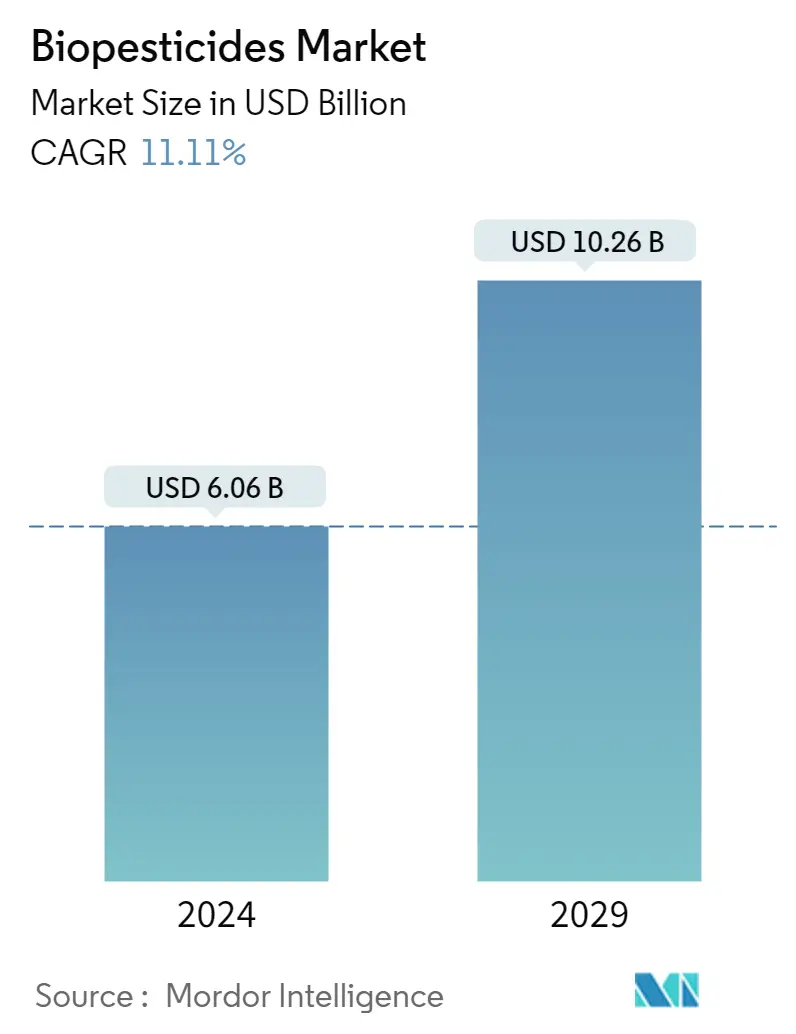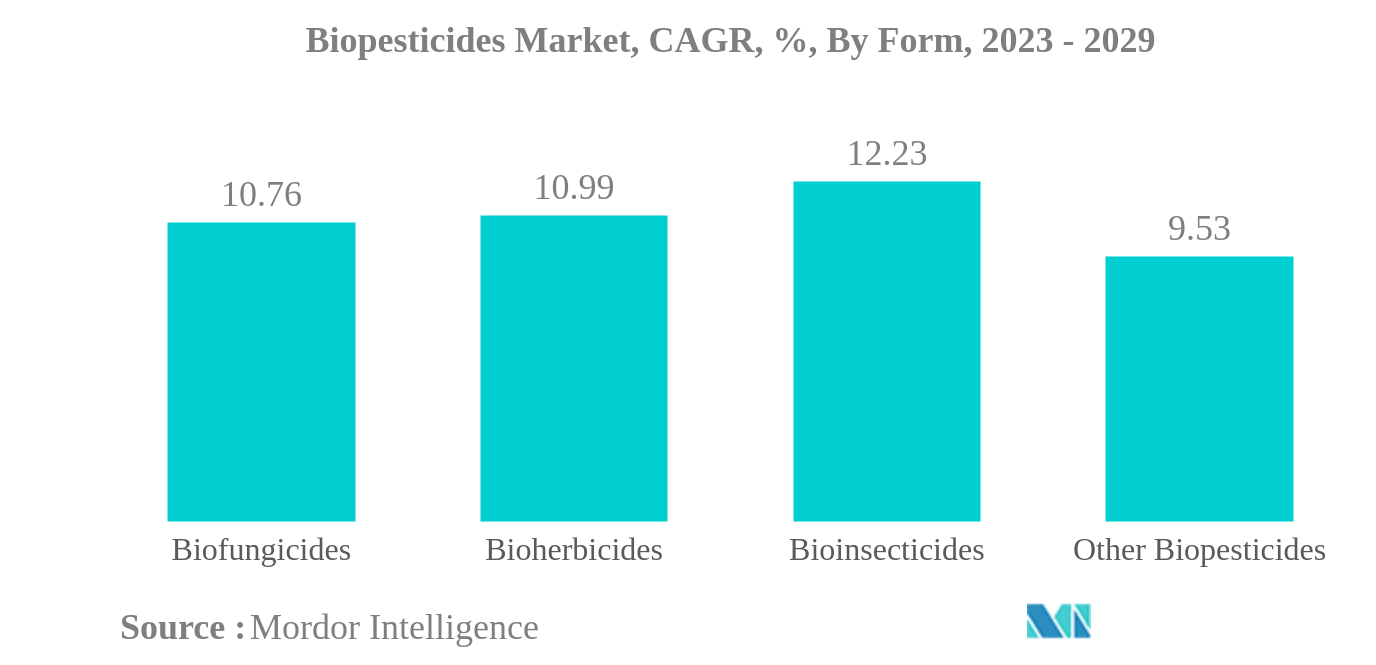Market Size of biopesticides Industry

| Icons | Lable | Value |
|---|---|---|
|
|
Study Period | 2017 - 2029 |
|
|
Market Size (2024) | USD 6.06 Billion |
|
|
Market Size (2029) | USD 10.26 Billion |
|
|
Largest Share by Form | Biofungicides |
|
|
CAGR (2024 - 2029) | 11.11 % |
|
|
Largest Share by Region | North America |
|
|
Market Concentration | High |
Major Players |
||

|
||
|
*Disclaimer: Major Players sorted in no particular order |
Biopesticides Market Analysis
The Biopesticides Market size is estimated at USD 6.06 billion in 2024, and is expected to reach USD 10.26 billion by 2029, growing at a CAGR of 11.11% during the forecast period (2024-2029).
- Biofungicides is the Largest Form. Commercial bio-fungicides available in the market provide protection against various pathogens such as Pythium, Rhizoctonia, Fusarium, Sclerotinia, Thielaviopsis, and Botrytis
- Bioinsecticides is the Fastest-growing Form. The application of Bioinsecticides in different pest-infested crops has significantly increased the mortality of harmful insects and decreased their progeny number.
- Row Crops is the Largest Crop Type. Rice, wheat, corn, soybean, sorghum, and barley are the major organic row crops produced and their dominanance in biopesticide consumption is due to the large organic area.
- North America is the Largest Region. The growing area under cultivation of organic crops and high adaption of biological solutions by the farmers of the region has made it the large consumer of biopesticides globally.
This section covers the major market trends shaping the Biopesticides Market according to our research experts:
Biofungicides is the largest Form
- Biopesticides are made from natural materials such as animals, plants, bacteria, and certain minerals. They are used to control pests in an environmentally friendly way by harnessing natural mechanisms of control. Biopesticides are often selective, and they target specific pests, thereby reducing the impact on non-target species and the environment. Biopesticides are also typically less toxic to humans and animals, and they break down more quickly in the environment.
- Biofungicides are the most popularly used biopesticides. They held a market share of 47.6% in 2022. Bacillus, Trichoderma, Streptomyces, and Pseudomonas are the most commercially used species of microorganisms in agriculture. These biofungicides effectively act against pathogens, such as Pythium, Rhizoctonia, Fusarium, Sclerotinia, Thielaviopsis, Botrytis, and powdery mildew.
- Bioinsecticides accounted for 27.9% of the global biopesticides market in 2022. There are several pests that cause devastating losses to specific crops in each season, which can be effectively controlled by using target-specific bioinsecticides. For instance, cotton is an important cash crop grown globally. The cotton bollworm pest affects the yield of cotton plants, irrespective of the region. Bacillus thuringiensis, a commercially important bioinsecticide, is known to effectively control this devastating pest that can cause potential yield losses of 30-90%.
- The effectiveness of biopesticides in controlling target-specific pests and diseases with no harm to the environment and animals is expected to drive the global market for biopesticides. The biopesticides market is estimated to register a CAGR of 11% during the forecast period (2023-2029).

Biopesticides Industry Segmentation
Biofungicides, Bioherbicides, Bioinsecticides are covered as segments by Form. Cash Crops, Horticultural Crops, Row Crops are covered as segments by Crop Type. Africa, Asia-Pacific, Europe, Middle East, North America, South America are covered as segments by Region.
| Form | |
| Biofungicides | |
| Bioherbicides | |
| Bioinsecticides | |
| Other Biopesticides |
| Crop Type | |
| Cash Crops | |
| Horticultural Crops | |
| Row Crops |
| Region | |||||||||||||
| |||||||||||||
| |||||||||||||
| |||||||||||||
| |||||||||||||
| |||||||||||||
|
Biopesticides Market Size Summary
The biopesticides market is experiencing significant growth, driven by the increasing demand for environmentally friendly pest control solutions. Biopesticides, derived from natural materials such as plants, animals, and minerals, offer a sustainable alternative to conventional pesticides by targeting specific pests and minimizing harm to non-target species and the environment. The market is characterized by the dominance of biofungicides, which are widely used to combat various pathogens, and bioinsecticides, which are rapidly gaining traction due to their effectiveness in controlling harmful insects. The largest consumer of biopesticides is North America, where the adoption of biological solutions in organic farming is on the rise. The Asia-Pacific region is also witnessing substantial growth, fueled by the expansion of organic farming in countries like China and India.
The biopesticides market is projected to continue its upward trajectory, supported by the increasing awareness of the adverse effects of conventional pesticides and the growing preference for sustainable agricultural practices. Government initiatives promoting organic farming and the ban on chemical pesticides in regions like South America further bolster the market's expansion. The market is fragmented, with key players such as Corteva Agriscience, Gujarat State Fertilizers & Chemicals Ltd, and Koppert Biological Systems Inc. actively participating in strategic collaborations and acquisitions to enhance their biologicals portfolios. These developments, along with the introduction of innovative products like Seipasa's "Fungisei," are expected to drive the market's growth and establish biopesticides as a crucial component of modern agriculture.
Biopesticides Market Size - Table of Contents
-
1. MARKET SEGMENTATION
-
1.1 Form
-
1.1.1 Biofungicides
-
1.1.2 Bioherbicides
-
1.1.3 Bioinsecticides
-
1.1.4 Other Biopesticides
-
-
1.2 Crop Type
-
1.2.1 Cash Crops
-
1.2.2 Horticultural Crops
-
1.2.3 Row Crops
-
-
1.3 Region
-
1.3.1 Africa
-
1.3.1.1 By Country
-
1.3.1.1.1 Egypt
-
1.3.1.1.2 Nigeria
-
1.3.1.1.3 South Africa
-
1.3.1.1.4 Rest of Africa
-
-
-
1.3.2 Asia-Pacific
-
1.3.2.1 By Country
-
1.3.2.1.1 Australia
-
1.3.2.1.2 China
-
1.3.2.1.3 India
-
1.3.2.1.4 Indonesia
-
1.3.2.1.5 Japan
-
1.3.2.1.6 Philippines
-
1.3.2.1.7 Thailand
-
1.3.2.1.8 Vietnam
-
1.3.2.1.9 Rest of Asia-Pacific
-
-
-
1.3.3 Europe
-
1.3.3.1 By Country
-
1.3.3.1.1 France
-
1.3.3.1.2 Germany
-
1.3.3.1.3 Italy
-
1.3.3.1.4 Netherlands
-
1.3.3.1.5 Russia
-
1.3.3.1.6 Spain
-
1.3.3.1.7 Turkey
-
1.3.3.1.8 United Kingdom
-
1.3.3.1.9 Rest of Europe
-
-
-
1.3.4 Middle East
-
1.3.4.1 By Country
-
1.3.4.1.1 Iran
-
1.3.4.1.2 Saudi Arabia
-
1.3.4.1.3 Rest of Middle East
-
-
-
1.3.5 North America
-
1.3.5.1 By Country
-
1.3.5.1.1 Canada
-
1.3.5.1.2 Mexico
-
1.3.5.1.3 United States
-
1.3.5.1.4 Rest of North America
-
-
-
1.3.6 South America
-
1.3.6.1 By Country
-
1.3.6.1.1 Argentina
-
1.3.6.1.2 Brazil
-
1.3.6.1.3 Rest of South America
-
-
-
-
Biopesticides Market Size FAQs
How big is the Biopesticides Market?
The Biopesticides Market size is expected to reach USD 6.06 billion in 2024 and grow at a CAGR of 11.11% to reach USD 10.26 billion by 2029.
What is the current Biopesticides Market size?
In 2024, the Biopesticides Market size is expected to reach USD 6.06 billion.

